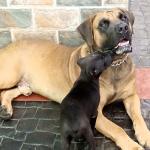How to determine the age of a puppy using the teeth

It is a common issue in our environment to buy a puppy without proper information as to the age and pedigree of the puppy. There are cases were vendors hawk these puppies at the road side and looking at these sometimes cute puppies you are tempted to buy. An ignorant buyer will just pay for a puppy without obtaining proper information about the age, breed or pedigree of the puppy. Puppies of any breed are usually cute and lovely to own but when the puppy is fully grown to a full adult issues of breed, pedigree and actual age comes into question. Age of any puppy or dog is an important factor or information for a proper health care for that pet.
Types of tooth in dogs
As in humans, dogs also have the 4 types of teeth namely:
1. Incisors
2. Canines
3. Premolars and
4. Molars.
These four sets of teeth erupt at different stages of the puppy’s development and life. Meaning that at a certain age a certain tooth type erupts or grows out. This is the basis of the age estimation.
Deciduous versus Permanent teeth
The deciduous teeth or baby teeth are the first set of teeth to erupt in the life of a puppy which are usually 28 in number i.e. 14 teeth on the upper jaw and 14 on the lower jaw as opposed to 42 permanent teeth or adult teeth having 20 teeth at the upper jaw and 22 teeth at the lower jaw.
Number of teeth types
1. Incisors Deciduous (6 L-J & 6 U-J) Permanent (6 L-J & 6 U-J).
2. Canines Deciduous (2 L-J & 2 U-J) Permanent (2 L-J & 2 U-J).
3. Premolars Deciduous (6 L-J & 6 U-J) Permanent (8 L-J & 8 U-J).
4. Molars Deciduous (none) Permanent (6 L-J & 4 U-J).
NB: L-J means Lower Jaw & U – J means Upper Jaw
Differentiating between the Deciduous and Permanent tooth
A deciduous tooth in looks appear smaller than the adult tooth and kind of triangular pointing downwards, they hardly fill the space of the gum at the root. In some cases they look irregular in arrangement. They are also very fragile and fall off to allow the permanent tooth to erupt at the set age of the puppy.
Age at Eruption of the Teeth Types
1. Incisors Deciduous (4-6 weeks) Permanent (12 – 16 weeks).
2. Canines Deciduous (3-5 weeks) Permanent (12 – 16 weeks).
3. Premolars Deciduous (5-6 weeks) Permanent (16 – 20 weeks).
4. Molars Deciduous (none) Permanent (16– 24 weeks).
Actual Estimation
Now let us do the real thing. With the chart above you can now be able to tell the age of your puppy by observing the teeth first of all to see if they are deciduous or permanent, then check the already erupted teeth types and do your estimation. You can only estimate here not to say the actual age of the puppy. We want to focus on puppies here because in adult dogs you can only use the wear and tear of the teeth to estimate the age which can be uncertain. If you can estimate the age at puppy stage you can now keep a record based on that estimate.
Example
Let us assume that a dog of 2 months was brought to us and we needed to be sure that the dog is actually 2 months old. What do we expect to see examining the teeth?
Answer
2 months means 8 weeks and some days so we expect to see:
· 6 deciduous incisors on the upper jaw and 6 deciduous incisors on the lower jaw,
· 2 deciduous canines on the upper jaw and 2 deciduous canines at the lower jaw,
· 6 deciduous premolars at the upper jaw and 6 deciduous premolars at the lower jaw,
· No molars present at all.
Try your hands on more examples!!
Now with this you can correctly tell the age of your puppy for accurate health documentation and records.









Well done and handy for not only those who buy a pup without full info available, but for those who know the age of their puppy and are just curious when the teething stages will start/end. Thank you!
Leave a Reply
Impressive and very handy particularly for the largely uninformed and clueless who buy pups by the roadside and depend solely on seller's info.
Leave a Reply